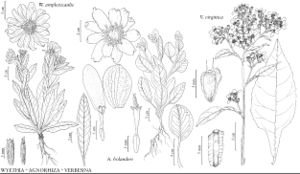Agnorhiza bolanderi
Phytologia 85: 19. 1999.
IllustratedEndemic
Basionym: Balsamorhiza bolanderi A. Gray Proc. Amer. Acad. Arts 7: 356. 1868
Synonyms: Wyethia bolanderi (A. Gray) W. A. Weber
Revision as of 22:07, 29 July 2020 by imported>Volume Importer
Plants (10–) 15–30 cm. Stems decumbent, seldom distally branched. Cauline leaves: blades oblong, ovate, rounded-deltate, or suborbiculate, 4–12 cm, bases ± truncate or cordate, margins entire, faces glabrous (shining, finely glanddotted, ± glutinous). Heads held among or beyond leaves. Involucres ± campanulate, 15–25 (–30+) mm diam. Outer phyllaries ovate to ovatelanceolate, 10–40+ mm (seldom surpassing ray corollas). Ray-florets (7–) 8–12, laminae (12–) 20–30 (–35) mm. Cypselae 7–9 mm, glabrous; pappi 0 or coroniform, 0.1–0.3 mm. 2n = 38.
Phenology: Flowering Mar–Apr(–May).
Habitat: Openings in chaparral
Elevation: 600–800 m
Discussion
Agnorhiza bolanderi is known only from the foothills of the Sierra Nevada, where it evidently grows only on serpentine soils.
Selected References
None.
Lower Taxa
None.
"broader" is not a number.
... more about "Agnorhiza bolanderi"
introrse +
connate +
herbaceous +
scarious +
absent +
hirsute +
papillate +
bristlelike +
continuous +
truncate +
suborbiculate;rounded-deltate;suborbiculate;rounded-deltate;ovate;oblong +
winged;ribbed;winged;ribbed +
1;15 +
stigmatic +
absent +
zygomorphic +
yellow +
winged +
dimorphic +
glabrous +
7mm;9mm +
staminate +
staminate +
Calif. +
straight +
glabrous +
distinct +
proximal +
1;5 +
bisexual +
dispersed +
singly +
discoid +
indeterminate +
Present +
surrounding +
campanulate +
petiolate +
alternate +
lance-deltate +
2-carpellate +
inferior +
attached +
anatropous +
persistent +
fragile +
falling +
absent +
coroniform +
tough +
thick +
absent +
connate +
persistent +
distinct +
falling +
Phytologia +
1999 +
pistillate +
absent +
fertile +
paleate +
flat;convex +
fibrous +
exalbuminous +
modifed +
2;3 +
alternate +
branched +
decumbent +
erect +
continuous +
2-branched +
papillate +
Agnorhiza bolanderi +
Agnorhiza +
species +
cylindric +
shorter +
cylindric +
shorter to longer than campanulate +
perennial +

